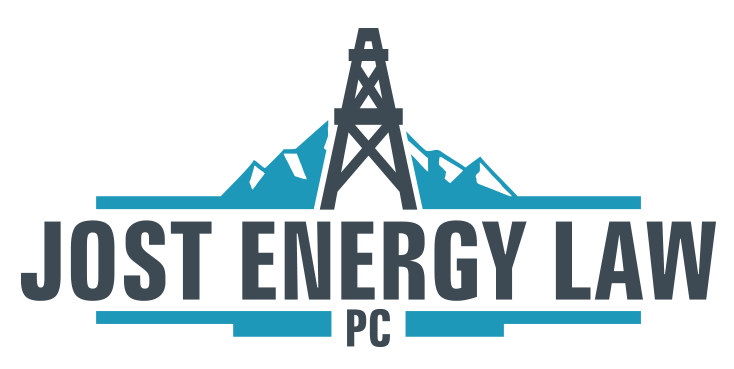News & Alerts
January 14, 2021 “DID YOU KNOW?” – JOST ENERGY LAW PRACTICAL TIPS FOR NEW COGCC RULES – DAY FOUR
In Day Four of Jost Energy Law’s “Did You Know?” Series, we continue to provide practical tips that serve to provide additional background on rules or processes that may otherwise not have been specifically addressed during the rulemaking or operator training meetings. The fourth set is below:
~ Rule 1201 – Wildlife Plans
- When preparing a new Form 2A, please remember that:
- Proposed Oil and Gas Operations on new or amended Oil and Gas Locations requiring a new Form 2A, Oil and Gas Location Assessment outside of High Priority Habitat require a Wildlife Protection Plan; and
- Proposed Oil and Gas Operations on new or amended Oil and Gas Locations within High Priority Habitat require a Wildlife Mitigation Plan that includes a description of the Rule 1202.a. operating requirements, and additional operating and mitigation requirements
~ 1202.d. – OGL Exceedance 1 per Square Mile
- When determining the siting for an Oil and Gas Location and/or conducting an Alternative Location Analysis for a new or amended Form 2A, please remember that:
- All Oil and Gas Development Plans submitted after January 15, 2021, including amendments to previously approved Form 2As, that cause the density of Oil and Gas Locations to exceed 1 per square mile in the High Priority Habitats listed in Rule 1202.d require a CPW-approved Wildlife Mitigation Plan pursuant to Rule 1201.b or other CPW-approved conservation plan and compensatory mitigation for Wildlife Resources pursuant to Rule 1203. This Rule 1202.d applies to the following High Priority Habitat types:
- Bighorn sheep migration corridors and winter range;
- Elk migration corridors, production areas, severe winter range, and winter concentration areas;
- Mule deer migration corridors, severe winter range, and winter concentration areas;
- Pronghorn migration corridors and winter concentration areas;
- Greater sage-grouse priority habitat management areas;
- Columbian sharp-tailed grouse production areas;
- Greater prairie chicken production areas;
- Gunnison sage-grouse occupied habitat and production areas;
- Lesser prairie chicken focal areas; and
- Plains sharp-tailed grouse production areas.
- All Oil and Gas Development Plans submitted after January 15, 2021, including amendments to previously approved Form 2As, that cause the density of Oil and Gas Locations to exceed 1 per square mile in the High Priority Habitats listed in Rule 1202.d require a CPW-approved Wildlife Mitigation Plan pursuant to Rule 1201.b or other CPW-approved conservation plan and compensatory mitigation for Wildlife Resources pursuant to Rule 1203. This Rule 1202.d applies to the following High Priority Habitat types:
~ 1203 – Compensatory Mitigation
- If an Operator has an Oil and Gas Location within any of the High Priority Habitats listed in Rule 1202.d., please remember that:
- An Operator is required to complete compensatory mitigation to Mitigate direct and Unavoidable Adverse indirect Impacts pursuant to Rules 1203.b–d.
- An Operator may fulfill the obligation to complete compensatory mitigation by:
- Completing or causing to be completed a project approved by CPW and the Director as described in a Compensatory Mitigation Plan pursuant to Rule 1203.b; or
- Paying a habitat mitigation fee (set forth in Table 1203-1) to CPW to reimburse all reasonable and necessary direct and indirect costs that will be incurred by CPW in completing compensatory mitigation sufficient to offset the direct and Unavoidable Adverse indirect Impacts to Wildlife Resources caused by the proposed Oil and Gas Operations.
- If requested by the Operator, then the Director may grant an exception from the compensatory mitigation requirement set forth in this Rule 1203 after consulting with CPW pursuant to Rule 309.e
- If an Operator chooses to fulfill its obligation to Mitigate direct Adverse Impacts to wildlife caused by new ground disturbance within High Priority Habitat types listed in Rule 1202.d by paying to CPW a habitat mitigation fee in the amount listed in Table 1203-1, then the Operator must pay such fee no less than 30 days prior submitting a Form 42, Field Operations Notice – Notice of Construction or Major Change pursuant to Rule 405.b.
- The current Direct Impact Habitat Mitigation Fees are:
- 1.00-10.99 Total Disturbance Acres = $13,750
- 11.0+ Total Disturbance Acres = Determined based on site-specific conditions and consultation with CPW.
~ Rule 309.e – CPW Consultation and Waivers
- Please keep in mind that CPW may waive High Priority Habitat buffers and Consultation when the Operator demonstrates and CPW agrees in writing that:
- The identified habitat and species triggering the consultation is no longer present and unlikely to return to the area; or
- The proposed Oil and Gas Location is within an area either primarily or completely developed for residential, agricultural, commercial, or industrial use that makes the area incompatible with wildlife habitat
- CPW may also waive High Priority Habitat Buffers and Consultation in the following two scenarios:
- The proposed new Oil and Gas Location would involve a one-time increase in surface disturbance of 1 acre or less contiguous with an existing Oil and Gas Location with a Wildlife Mitigation Plan or other conservation plan that remains in effect for the area.
- A Commission Order limits the density of Oil and Gas Locations within a Drilling and Spacing Unit to 1 per section, and the Order includes a Wildlife Mitigation Plan or other conservation plan that remains in effect for the area.
- For the aquatic High Priority Habitats, CPW may waive the application and the Director may grant an exception to Rule 1202.c.(1).R for any new ground disturbance that meets the criteria of Rule 1202.c between 300 feet and 500 feet from the Ordinary High Water Mark (“OHWM”) of cutthroat trout designated crucial habitat, and native fish and other native aquatic species conservation waters, if the Operator adheres to the enhanced Best Management Practices outlined in the Intermediate Buffer Zone for the Public Water System Rule 411.

